News
Snaring and digital kangaroo courts – experts cry foul
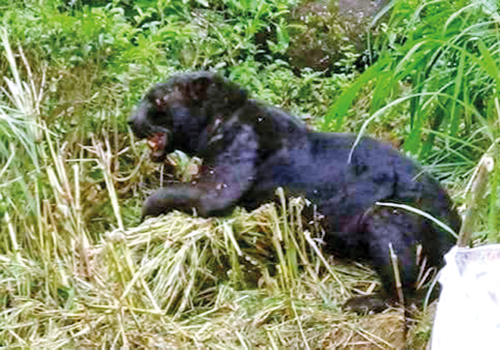
The heartrending sight of the black beauty caught in the snare at Nallathanniya
A black beauty is dead – the magnificent black leopard which was captured by camera traps several months ago in the Central Wildlife Region succumbed on May 29 after getting caught in a snare in an estate in Nallathanniya, close to Adam’s Peak.
Tranquilizing the growling, struggling and distraught, obviously-in-agony leopard, the Veterinary Surgeons of the Department of Wildlife Conservation (DWC) rescued the animal amidst curious and ogling crowds on May 26. It died three days later while being treated in the DWC’s only Intensive Care Unit (ICU) at the Ath Athuru Sevana (Elephant Transit Home) in Uda Walawe.
The Sunday Times understands that the snare had been around the black leopard’s neck.
This was as police arrested the alleged poacher who set the snare and produced him in court, with an independent post-mortem report on what caused the death of the black leopard being awaited from the Peradeniya Faculty of Veterinary Science. The suspect has been released on bail and the case is due to be called on July 29.
While Sri Lanka mourns this black beauty, many arm-chair critics were quick to jump into the fray to bash the DWC for “incompetence and mismanagement”, without giving this institution whose mandate is the conservation of wild animals the benefit of the doubt and awaiting the autopsy report.
“This is deplorable,” was the view of many including die-hard conservationists, who having viewed the footage of the tranquilizing of the black leopard to treat it for its injuries were empathetic towards the DWC officials.
Many pointed out that the black leopard was very stressed having struggled in vain to escape the snare, while also “unnaturally” being amidst humans.
Whatever the DWC did, it would have been deemed wrong, others pointed out, underscoring that before severe criticism is levelled against its officials, the cause of death of the black leopard should have been ascertained.
Not much focus was given to the deadly snares, others told the Sunday Times, explaining that it was just in passing that snares were mentioned.
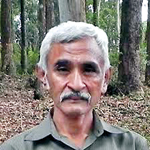
Lawyer Jagath Gunawardena
Snares have not only killed black and other leopards (Panthera pardus kotiya) in Kalawana, Sinharaja and Deniyaya, but also led to horrible injuries in other animals including elephants. Others which fall victim to snares are kebellawo (pangolins), mee-minno (mouse deer), barking deer, spotted deer, sambhur, wildboar and even livestock.
A snare is a trap with a noose of wire or cord. Once an animal gets caught, the more it struggles, the more the wire or cord gets tightened, cutting deeply into its flesh.
“One of the most inhumane forms of poaching is snaring. Snares are laid to capture wildlife for bush meat or wild animals that may damage crops. Whatever the reason, snaring puts an animal through agony and generally causes internal injuries which could be fatal. The recent snaring and subsequent death of a black leopard has resulted in the public blaming the DWC for mishandling the situation. In my opinion, the person at fault for the leopard’s death is the person who laid the snare. Had the snare not been laid, the black leopard would not have been caught in the snare. If the leopard had not been caught in the snare it would not have died,” said former DWC Director-General Dr. Sumith Pilapitiya.
Forty-seven leopards including the black leopard have got caught to wire snares in the past 10 years, of whom 42 have died, the Wilderness & Wildlife Conservation Trust told the Sunday Times. The 47 include the leopard which was released at Yatiyantota on May 30 and the decomposing carcass found in Neluwa.
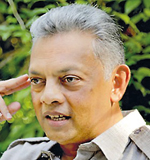
Dr. Sumith Pilapitiya
Dr. Pilapitiya pointed out that to make matters worse, when people gather around the animal, not being used to human presence, the leopard would have tried harder to flee, with the potential of inflicting much harm on itself. This is why people should be kept out of sight of the leopard, he said, explaining that when the DWC vets arrived, the animal may have been injured badly.
“It is very easy to second-guess what the vets should or should not have done, after the incident. However, when faced with a situation such as this, the vets have to work under tremendous pressure and in conditions that are certainly not ideal. Could mistakes have been made? It is possible, but who am I to judge when I was not present and neither am I a vet,” was Dr. Pilapitiya’s frank view.
A post-mortem has been undertaken by an independent entity – the Veterinary Faculty of the Peradeniya University. “Let’s wait for the report to be submitted to court before assigning blame. Based on the report, if the DWC has been negligent, then it should be held accountable. But until then, I do not want to be the judge, jury and executioner,” he added.
Referring to recent demands for the DWC to protect black leopards, Dr. Pilapitiya said all leopards should be protected in the wild, not only the black leopards. There should be a strategy and action plan for dealing with leopards outside the Protected Area network, especially those in the hill country. The need is to work jointly with the plantation management companies to ensure that their labour and the local communities are dissuaded from laying snares. This requires targeted awareness creation and monitoring. The areas that are vulnerable have to be patrolled jointly by the plantation management and the DWC with assistance possibly from the Special Task Force.
“We have to stop snaring. As long as there is snaring, leopards and other wildlife are vulnerable,” he added.
Setting of snares is a clear violation of the law, whether it is under the Cruelty to Animals Act or the Fauna and Flora Protection Ordinance (FFPO) which gives special cover for protected species such as leopards, said environmental lawyer Jagath Gunawardena, who also echoed strong sentiments against “digital kangaroo courts” where so-called experts were quick to act as witnesses, prosecutors and judges and condemn the DWC’s decisions taken under trying conditions.
This is a dangerous trend in environmental conservation, where social media are used to malign institutions and individuals, without the latter being given a fair chance to defend themselves. If people have evidence of negligence against the DWC, which certainly should not be based on whims and fancies, they should produce such evidence before court, which is the right forum, where justice would be meted out, he reiterated.
The black leopard matter is before court now and they can present their evidence there, urged Mr. Gunawardena.
The black leopard being “caught” on remote-sensing camera traps set by DWC’s Veterinary Surgeons Dr. Malaka Abeywardana and Dr. Manoj Akalanka was reported in the Sunday Times of January 26, 2020 headlined, ‘Spotted: The black beauty’.
The black coat (background fur) which obscures the spots of these leopards is due to melanism and a single recessive gene for coat colour. Other leopards have coats which vary in colour from straw to bright golden, spotted with black spots and rosettes.
| Suggestions by the WNPS | |
| Declare May 29 as ‘Sri Lanka Leopard Day’ in commemoration of the death of the black leopard, the Wildlife and Nature Protection Society (WNPS) has urged. Calling for the setting up of an equipped Wildlife Rescue and Treatment Centre in the central highlands, the WNPS seeks detection, prosecution and penalizing of users of illegal wire-snares. It also seeks a set of protocols when dealing with wildlife emergencies such as the recent incident, which should include coordination, planning and rapid response as well as training and capacity building for wildlife rangers and vets to face such situations in the field.
|
| The lingering agony of snared elephants | |
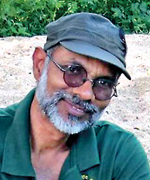 Dr. Prithiviraj Fernando Snares, in most cases laid to get bush meat, are one of the biggest threats to wild animals, underscored Dr. Prithiviraj Fernando of the Centre for Conservation & Research (CCR) who has experienced first-hand the agony of baby elephants which have suffered grievous injuries due to them. 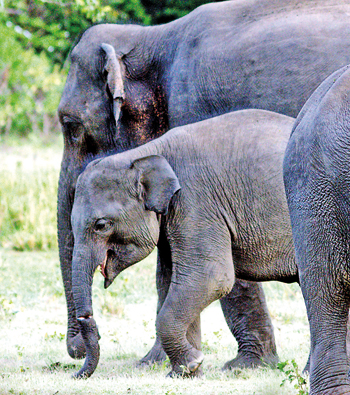 The trunk of this baby in Kalawewa has been cut by a snare (Pic courtesy CCR) Those who set snares do not keep one or two but hundreds, causing lingering suffering and death to many animals, he said, citing instances where baby elephants had their trunks severed which cause them to starve to death or a leg caught which becomes swollen and gangrenous causing death. “In the case of adult elephants, the snares commonly entrap a leg. When the elephant struggles, the wire breaks at the other end but the noose around the leg remains, cutting into the flesh and getting embedded. A festering, suppurating wound ensues around the embedded wire, gradually eating into the leg. After much suffering, the elephant may finally die of sepsis,” says Dr. Fernando, recalling how when the DWC was collaring wild elephants with CCR, on some occasions the veterinarians had to remove embedded wires and treat wounds. “To stop the setting of snares, the bush meat trade – which also has implications for diseases such as corona – should be banned, penalties for setting snares increased and most of all they should be implemented. An awareness campaign against bush meat, snares and hakkapatas is critical to bring peer pressure against these activities,” he says.
|
| “We did our best,” says DWC Vet | |
| The emotion was tangible as the death of the black leopard was spotlighted at a media briefing held by the State Veterinary Surgeons’ Association (SVSA) on Wednesday. “We are very sad about its death but many people, not only on social media but also in the mainstream media, are creating a wrong impression about the veterinary surgeons of the Department of Wildlife Conservation (DWC) by alleging that we didn’t do our job,” said DWC’s Dr. Suhada Jayawardana who is looking after the Western Region. He is among 17 state veterinary surgeons attached to the DWC. 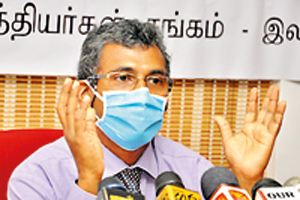 Dr. Suhada Jayawardana. Pic by Priyantha Wickramarachchi He reiterated that with the resources available, they did everything possible, their “best” but unfortunately they were not able to save the black leopard. Point-by-point, Dr. Jayawardana deals with the allegations. “People say it took three hours for us to get to the black leopard. It was a difficult journey because it had got caught to the snare on the border of a jungle and we got there as fast as possible,” he said, adding that another allegation was that the animal was not handled properly. “We cannot treat a wild animal like we would a pet dog or cat. There is no way to check its fever or heart-rate and those who tranquilized the black leopard were very careful not to overdose it and gave it only 1/4th of what we would have given because it was weak,” said Dr. Jayawardana. Taking up the issue of the cage being too small, when it was being treated, he said that when wild animals are caged in big spaces, unlike animals in a zoo, they don’t realize that they are restricted and try to lunge out, severely injuring themselves. On an earlier instance a leopard under treatment after a similar problem, jumped against the bars of its cage and injured its eye, leaving it blind in one eye. Others claim that this black leopard was used to a cool climate and when taken to Uda Walawe, the climate would have affected it. The only ICU of the DWC is in Uda Walawe and the black leopard was in an air-conditioned area, he added. Dr. Jayawardana urged that immediate steps be taken to halt the use of snares. Sometimes many people including those on estates and government officials turn a blind eye to snares as this is their “supply line” for illegal bush meat.
|


